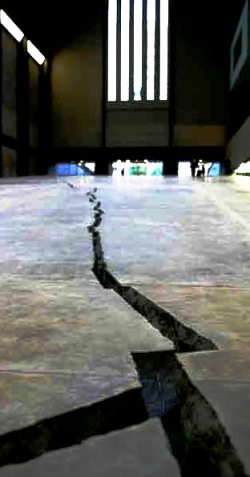
Ted Nield ventures up “Doris’s crack” and wonders if reactions to the work set the technically minded apart...
You’ve got to hand it to Doris Salcedo, of the now world-famous Tate Modern crack. It's not just art with an edge – it’s art with two edges. And if modern conceptualists set out to be "dangerous" then she has certainly succeeded. Because within a week of its opening (sorry) several members of the public – who had presumably gone there expressly to see the thing – had fallen into it.
What’s Shibboleth about? It’s all in the title, the word deriving from the practice of the people of Gilead, east of the River Jordan, who according to the Old Testament used that word to root out their sworn enemies Ephraimites (one of the 12 tribes of Israel) as they tried to cross the Jordan. Ephraimites, unable to say “sh”, gave themselves away immediately. Doris’s crack is all about racism, and all intolerance that engenders division. Well, so much for the art bit - I trust you didn't find it too taxing.
Doris's crack starts as a hairline fracture under a dustbin near the entrance. It then gradually becomes a stiletto-snapper, forks like lightning, vanishes under walls, and finally widens into a chasm large enough to swallow any unsupervised child with no sense of personal danger, revealing what seems to be fence-wire embedded in its walls – recalling the great symbolic boundaries of our time – the Berlin Wall, Guantanamo Bay, the compound in Ardman Animation’s Chicken Run, and so forth. Shibboleth stretches the 167m length of the Hall and, at its most Grand Canyon-like, is about 30 centimetres wide and a metre deep.
What strikes me about this piece is how people’s reactions to it have divided the artists from the public. While the artist witters on about her profound meaning, most of the visitors are more interested in how it was done. On this, Doris herself and the Tate, have remained silent – fearing no doubt that mundane concern with technique (something conceptual artists usually scorn, for obvious reasons) will crowd out questions about “meaning” and the artist's intentions. Compared to these supposed profundities, concern about how the trick was pulled is merely technical - leading only to proximal rather than ultimate causes. Philosophically such reasons hardly seem grand enough. Nevertheless, this work has stimulated the question “how” like few others.
This must be encouraging because “how” is the scientist’s question. Geologists and engineers spend a lot of time staring up cracks because they tell them a lot. Is this metal casting about to break? Is this building about to drop on my head? Is this continent about to rift from its neighbour? Answers to all these interesting and useful questions can all be found in the humble crack. Scientists ask the question “how” because it leads them to understanding something about the way Nature works. How do mountains rise? How do faults move? How can a crack appear in the floor, widen at the speed your toenails grow, and become the Atlantic Ocean? Science can’t tell you why any of this happens, but it can tell you how. And this is useful knowledge – we cannot say
why the HIV virus exists, and it is pointless asking. But we can find out
how.
So for my money, the question “how” is exactly the one we should be encouraging the public to ask. The search for ultimate causes leads us only into the barren wastes of a philosophical Gilead - the supernatural – exactly what divides more people in the world from their neighbours than anything else.
If we could but unite behind the question “how”, the reign of the shibboleth is over.